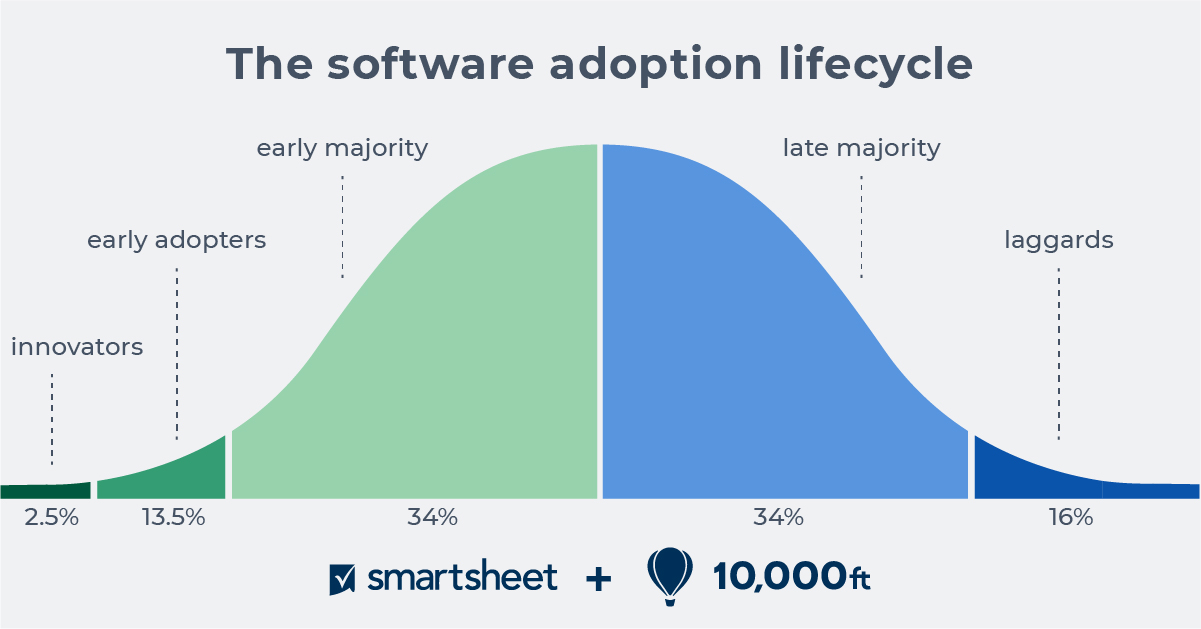After months of research and sitting through demos, you’ve finally chosen a new software tool for your business. What a relief!
Sadly, you’re not home free yet. Implementing any kind of new technology in the workplace — including this new software — is a company-wide change that can really stress people out. Why?
Because people generally resist any change that impacts their status quo. And asking them to learn yet another new tool will certainly feel like an unwelcome disruption.
If you aren’t completely clear about why it benefits them and their workflow, they’ll be skeptical. Or worse; resentful.
So, how can you successfully implement new software, so your employees welcome it with open arms?
The path to successful software adoption
You may not be able to sell everyone on this new software rollout.
Adoption rates will vary depending on your employees' openness to new technology and their willingness to learn a new tool.
Consider Everett Rogers’ classic model of technology adoption over time:
Following this model of software adoption, your employees may fall into one of five groups:
- Innovators. These are technology enthusiasts by nature, and they're excited to dive in and figure out how the new software can improve their existing workflows.
- Early Adopters. Like innovators, these users will try new software faster than the majority. Getting buy-in from this group is critical, because their opinions influence how the Early Majority feels about trying the new tool.
- Early Majority. This group is more practical in their approach to new software. The Early Majority typically waits until software is vetted by others. They want to know how new software improves their existing workflow before they feel comfortable adopting it.
- Late Majority. These users will only adopt new software when they need to, or when it becomes unreasonable not to. The Late Majority will use the software once you’ve made it a concrete part of your business operations.
- Laggards. Laggards tend to use familiar technology and software as long as they possibly can. They’re often uncomfortable learning and using new tools. The only way to move this group may be to force them to use the new software by eliminating legacy options.
Understanding these user types will help you think strategically about your rollout plan, and how it may affect each of these five groups.
If you can build enough momentum with Early Adopters, for example, it will be easier to convince the Early Majority. And once the Early Majority adopts your new software, you’ll be well on your way to getting the rest of your team on board.
Now, let’s dive into five tips to help your software rollout succeed across all five user groups.
5 tips to improve your software implementation plan
Here are five tips for training employees on new software and improving participation rates, regardless of your organization’s size or what software you’re introducing.
1. Find your champions
If you can leverage the excitement of your Innovators and Early Adopters to build momentum around this new software, they can help convince the rest of your employees to use it.
Find people who will be naturally comfortable with the software’s concepts, and encourage them to advocate on its behalf.
You might consider people from the pilot team that helped evaluate the tool, or the people that will be using the software most often. Seeing the enthusiasm of these champions will help convert people who are more skeptical or hesitant. Ask them to share their experience of learning the new software and offer help to struggling employees.
2. Create a shared understanding
If employees can't find a compelling reason to use the new software, you can almost guarantee low adoption rates.
So, help your champions understand exactly what the tool is, what it does, and why you chose it. Involve people early in the implementation process. Encourage questions and be transparent with your answers.
Make sure everyone clearly understands how you evaluated other tools, and why this software stood apart. The better your champions understand the software and your reasons for choosing it, the better they’ll be able to share its value with the rest of your team.
3. Hold training events
Training events can be an effective way to train your employees on new software. Use these events to encourage dialogue and answer questions, reinforce the tool’s benefits, and demonstrate its everyday practical application in your team’s workflow.
You can also incorporate the new tool into regular meetings. Look for creative ways to incorporate the new software into your routine as often as you can.
4. Move important content to the new software
One way to increase adoption is to make important information your employees need only accessible via the new tool. In fact, setting a hard deadline for migrating to the new software may be the only way to get your Laggards to convert.
Be careful. This is a bold step that runs the risk of frustrating your employees, especially if implemented too early. But if you communicate your reasons effectively and express how the new tool will benefit them and organization overall, you increase the chances that they’ll accept the change without complaints.
5. Consider rewards and gamification
Rewards can be an effective way to encourage a certain behavior but it depends on your work culture and philosophy.
It's important to note that carrots and sticks tend to fall short when trying to motivate creative thinkers (and can even be damaging). True motivation is driven by a sense of purpose and pursuit of mastery, which is why conveying the software's value is so important.
That said, small rewards to encourage participation can be quite effective when dealing with less creative tasks, like time-tracking.
Successful implementation with less stress
Implementing new software isn’t easy, and it’s difficult to know just how much stress different people will feel during the process.
Bottom line? Early adoption is a vital part of every successful software rollout.
Creating a shared understanding and clear expectations early on will help your employees feel more at ease during the transition and ensure that your new software will become an integral part of your company’s workflow.

